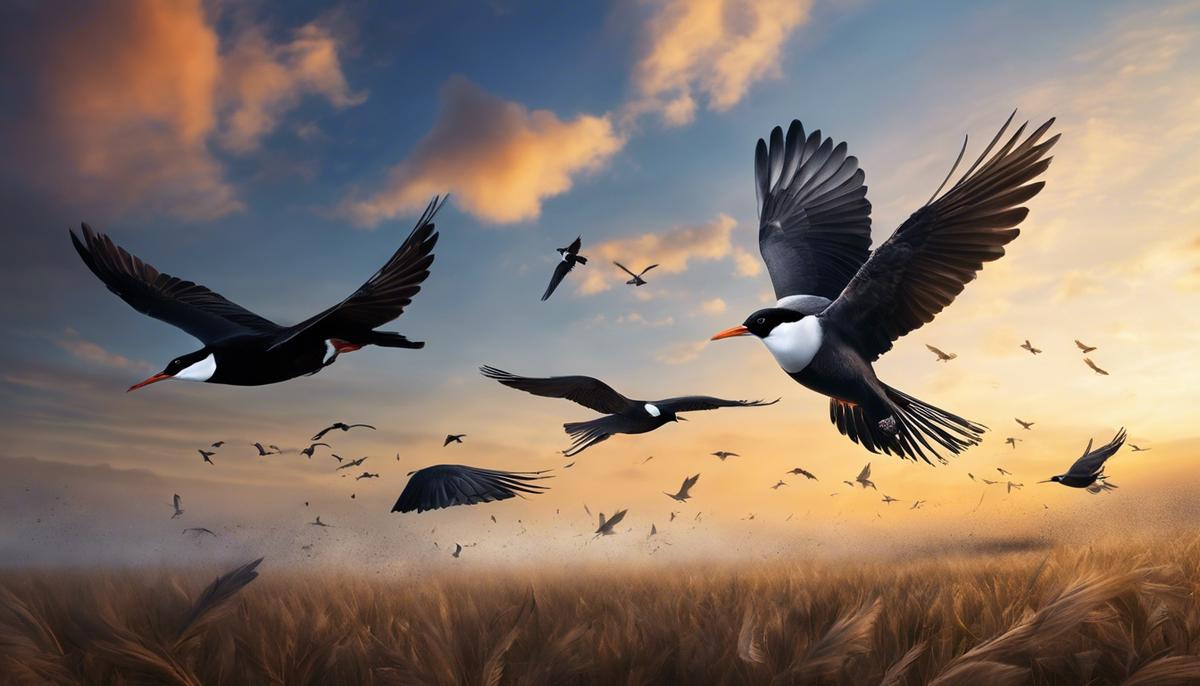The human mind is a fascinating enigma that continually compels us to probe deeper into its mysteries. Dreams, which are an artifact of this wandered mind, offer a unique window into our subconscious, translating invisible thoughts and feelings into a language of their own: symbolism. Among these are the recurring dreams of flying like a bird, captivating the dreamer with an exhilarating sense of liberty and soaring high above the mundane world. An exploration into the psychological implications of these dreams – examining them from the prism of Freudian and Jungian theories – reveals how they might be tethered to our longing for freedom, spiritual transcendence, and self-growth. Bridging the gap between the conscious and the subconscious, such dreams hold a mirror up to our deepest insecurities, ambitions, and desires.
Psychological Implications of Flying Dreams
The sophisticated landscape of the human mind with its multi-layered intricacies has intrigued scholars and psychologists for centuries, provoking curiosity and scientific endeavors aimed at deciphering its mysteries. Among these enigmas, dreams have been particularly mesmerizing, and the recurrent theme of experiencing flight in these episodic nocturnal narratives continues to captivate the psychological discourse. Intriguingly, dreams about flying like a bird are not merely figments of imagination devoid of logic, but may offer profound insights into the nature of cognitive processes, the human emotional state, and psychological health.
To transpose the ethereal nature of dreams into understanding concealed psychological aspects requires a robust framework of reference. In this context, the theories propounded by Sigmund Freud and Carl Jung provide a significant foundation for exploration. Where Freud emphasized the role of suppressed desires and traumas, Jung shed light on the collective unconscious. In both perspectives, flying dreams could be interpreted as a medium to express unfulfilled aspirations, feelings of empowerment, or as an escape mechanism from the tribulations of waking life.
Delving deeper into the Freudian landscape, the idea of flying resonates with suppressed desires for freedom. Dreams of flying like a bird could thus denote an unconscious yearning for liberation. Furthermore, the feeling of soaring through the sky might be reflective of moments of personal triumph or achievement, suggesting a correlation between these dreams and an individual’s self-esteem or sense of accomplishment.
Jung, on the other hand, deliberations around the flight motif connects it with inherent human archetypes – ancient and universal symbols internalized within our collective unconscious. From this perspective, dreams about flying can be perceived as connected to mankind’s deep-seated desire for transcendence and exploration, essentially mirroring an exploratory instinct and symbolizing the quest for personal growth and self-actualization.
However, while these interpretations illuminate the positive aspects of flying dreams, it’s crucial to consider the potential implications of stress and anxiety. Some psychological theories propose that such dreams may also function as a metaphorical escape route from burdens or fears in reality, representing a subconscious effort to evade confronting real-life issues.
Contemporary neurological research has further advanced understanding of these particular phenomena. Correlations between REM sleep patterns and flying dreams have been established, suggesting that brainwave activity might directly influence dream content. Consequently, these patterns in neural activity might also reflect differing mental states depending on the individual, with tranquil flights denoting equanimity, and more tumultuous experiences potentially reflecting internal unrest.
In conclusion, dreams about flying like a bird paint a variegated picture of the human psyche, offering a fascinating glimpse into the undiscovered territories within. These visions not only represent psychological states but also shed light on the profound interconnectivity between the dream world and waking life. Scholars, psychologists, and dream enthusiasts alike continue to probe the depths of these puzzling phenomena, spurred by the tantalizing promise of new insights into the enigmatic human psyche.

Cultural Interpretations of Bird Flying Dreams
The Cultural Variances in Interpreting Dreams of Flying Like a Bird
Understanding dreams, specifically dreams about flying like a bird, is a global preoccupation that transcends diverse cultures and societies. This multi-disciplinary topic has been analyzed, yet the discussions are far from over. Usually, biological, psychological, and sociological perspectives are widely discussed. However, what’s intriguing is the anthropological viewpoint – the examination of how different cultures interpret dreams of flying.
With the wealth of wisdom indigenous societies possess, these cultural responses address the symbology of dreams such as flying, connecting it with spiritual nuances and interpretational depth. For instance, in Native American culture, dreaming of flying like a bird is perceived as an auspicious sign, often holding a spiritual or divine message. They believe it signifies freedom, higher perspective, or spiritual progress, relating it to a bird’s elevated flight and overarching view of their surroundings.
On the African continent, however, the interpretation of such dreams marginally diverges. Many cultures, like the Yoruba and Zulu tribes, regard dreams of flying as a connection to the ancestor realms. They believe that flying equates to the dreamer’s soul traversing between physical and spiritual worlds, therefore indicating a strong spiritual inclination or a divine message from the ancestors.
Contrarily, Eastern Asian philosophies provide a different perspective. In Chinese culture, dreaming of flying is associated with prosperity, success, and upward mobility. The altitude of the flight in dreams can be perceived as an indicator of the dreamer’s aspirations or potential achievements. Conversely, in Japanese folklore, such dreams might be considered a spiritual journey, akin to astral projection, thereby connecting it to the realm of the supernatural.
In South Asian cultures, the interpretation hinges between auspicious implications and spiritual journeys. In Indian and Nepalese societies, there is a strong belief in karma and reincarnation, hinting that dreams of flying could symbolize liberation, advancement in spiritual paths, or accruing good karma.
However, despite the profound interpretations, the objective nature of evidence-based science also acknowledges the influences of cultural, personal, and emotional factors in shaping our dreams. Therefore, it is essential to treat these cultural interpretations with deference, while also appreciating the purely psychological, biological, or even neural network-related factors that contribute to these complex experiences of the dreaming minds.
In conclusion, there is an apparent universal curiosity around dream interpretations, particularly flying dreams, that spans cultural constructs and geographical boundaries. Although the majority of the cultural responses associate flying dreams with spiritual messages, freedom, or natural human aspirations, the existing interpretations are as diverse as the cultures themselves. Flying dreams, thus, reflect a dynamic blend of universal human experiences and culturally nuanced interpretations, adding a new dimension to human understanding.

Scientific Analysis of Bird Flying Dreams
As inquiries into dream interpretation further stretch from the Eurocentric discourses of Carl Jung and Sigmund Freud, the quest for understanding dreams of flying like a bird necessitates a multidisciplinary approach, incorporating insights from biology, psychology, sociology, anthropology, and cross-cultural comparisons.
On a biological perspective, scientific advances today allow for exploration into the correlation between brain activity and dreaming. In particular, quantitative electroencephalogram (QEEG) studies suggest that specific brain wave patterns and localized brain regions are activated during dreams about flying. Such research contributes to neuroscientific understandings that associate these dreams to an interaction of brain functions involving memory, emotion, and sensory experience.
From a psychological viewpoint, cognitive scientists propose that our minds may generate flying dreams as a process of solving real-life problems or simulating future scenarios in a safe space – the dream world. This could explain the profound feelings of liberation, opportunity, and escape often associated with these dreams.
Incorporating a sociological perspective implies acknowledging the social environment’s influence on dream content. Studies suggest that societal norms, beliefs, and values can be subtly reflected in our dreams. Thus, dreams about flying like a bird could also serve as a societal mirror, capturing traces of the zeitgeist in dream imagery.
When we turn to anthropology, dreams of flight are found to be surprisingly universal across cultures, despite differences in interpretation. Native American lore, for instance, holds that dreams about flying suggest spiritual freedom and connection with the divine. On the African continent, dreams of flying could be prophesising spiritual elevation or ascension to a higher social status. Eastern Asian cultures interpret such dreams as a good omen indicating high achievements and aspirations. In contrast, South Asian interpretations lean towards the spiritual realm, viewing such dreams as a sign of liberation and transcendence.
As we delve into the curious world of dream interpretation, to decipher the various meanings behind dreams of flying like a bird, the integral role of diversity bubbles to the surface. The interpretation of flying dreams is not a one-size-fits-all process, but invites an embrace of variation and individual nuances. Personal experiences and strong emotions greatly influence dream content, while cultural traditions and social norms provide a framework for interpreting dreams.
In addition, understanding the impact of neural networks, the biological facets of our bodies, and the psychology embedded in our conscious and subconscious minds, seems pivotal to unfold the dream enigma. Therefore, the dream of flying like a bird, in all its captivating majesty, poses a fascinating challenge to science, extending beyond the borders of academic disciplines and spurring perpetual exploration into the fascinating terrain of the human psyche.
Unravelling the mysteries and interpretations of dreams of flight, consequently, reminds us of the multifarious nature of human experience – divulging the profound interconnectedness of biological, psychological, sociological, and cultural elements, which, harmoniously intertwined, orchestrate the enigmatic symphony of dreams.

Culture, science, and psychology merge beautifully to weave the narrative of our dreams, more so in those that involve winging across the sky like a bird. Unraveling the neurophysiological processes underpinning these dreams, from the intricacies of the REM phase of sleep to the complexities of our cognitive psychology, paints a captivating tableau of the operational machinery of our mind. Yet, it also underscores the challenge in deciphering the enigma that is the human mind – reminding us that each dreamer’s subjective experience and cultural backdrop can lend different hues to their dreams of flight. Therefore, despite the scientific strides, the interpretation of dreams about flying like a bird remains as diverse and nuanced as the dreamers themselves.







